LiftUp is a Microsoft Teams application designed to foster appreciation within your organization through the power of praise, ultimately enhancing team culture.
On this page you find all the information necessary to install LiftUp into a single team or rollout it out into the organization.
This guide talks you through the basic setup of LiftUp into a team and the most important configuration settings.
The following guide covers the rollout of LiftUp into an organization. You learn how to grant permissions for all users, how to restrict LiftUp to certain user groups (if desired), how to preinstall it for every user and how to add it to a Team template.
Teams apps have various touchpoints to interact with team members and users: Team, Personal and Chat (for more information on the different modes of LiftUp, see the Anatomy of LiftUp.)
LiftUp should be installed in at least one team as this is where given praise is most effective.
To install LiftUp in a team, add LiftUp in the Microsoft Teams Appstore and make sure to “Select a channel” from the team you want LiftUp to be installed in.
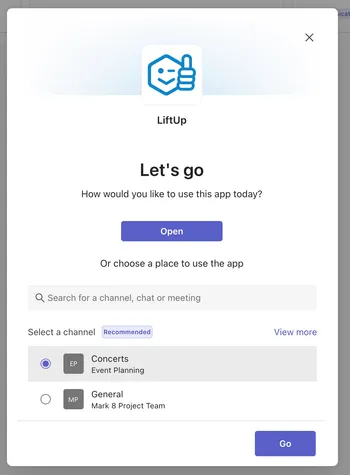
You’ll see a short introduction dialog. Press Save to install the LiftUp bot in the corresponding team, making it accessible in all channels of the team.
Additionally, the channel tab of LiftUp is installed in the specific channel you selected.
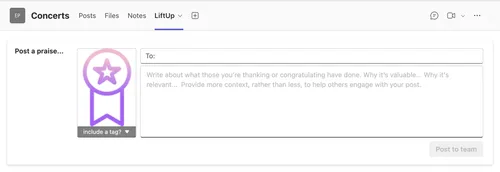
Sometimes, Microsoft Teams looses track because of permission dialogs it shows and forgets to install the Team tab. You then have to install it manually.
LiftUp also installs as a message extension which allos to open its editor directly from the message box.

Installing LiftUp in a single team is sufficient for a test run. However, for company-wide usage, it is recommended to install LiftUp in as many teams as possible for maximum visibility. To ensure LiftUp is installed in all new teams, set up a Microsoft Teams template with LiftUp included.
If a template is not an option, or if you have many existing teams and do not want to add LiftUp manually, scripting may be necessary. If you prefer PowerShell, this page can help you get started. Alternatively, contact us for a JavaScript that can be run periodically as a cloud function to ensure LiftUp is installed in all teams.
The “Team tab” is optional but recommended, as it provides team-specific user and praise statistics. To install a LiftUp tab in any channel, select the + button next to the channel tab list and search for LiftUp.

LiftUp can also be used in a chat. This requires the installation of the LiftUp bot and optionally the tab into a chat. The process is the same as described for a team, but scroll further down to “Select a chat”
Chat-based praise must be enabled in the administration area of LiftUp.
Check the configuration guide for more info.
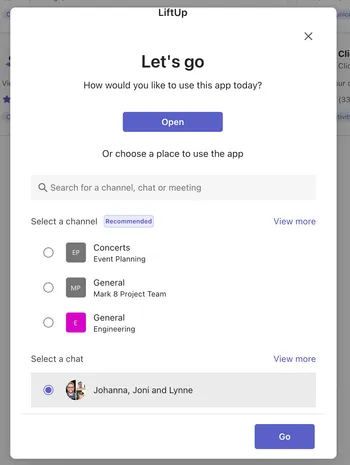
LiftUp can be opened in personal mode as well, giving access to personal user settings and the administration area of LiftUp. To open in personal mode, LiftUp needs to be added from the left sidebar. Select the three dots, and search for LiftUp.
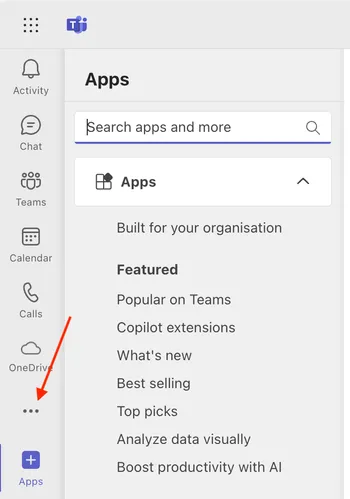
To keep it always visible, right-click the LiftUp symbol in the left sidebar and select Pin.
To add LiftUp to all users’ sidebars by default, visit the Teams Admin Center->Teams App->Setup policies and change your policy to add LiftUp into the sidebar of all users.
LiftUp has its own administration section found by opening LiftUp in personal mode and selecting the “Settings -> Administrators” menu. This section shows organization-wide statistics and allows the configuration of global settings (e.g., tags and challenges). Also an administrator has the ability to remove praise messages in case inappropriate content is posted.
In the free plan, everyone who installs LiftUp in personal scope is added as an Administrator. In paid plans, everyone who installs LiftUp to a Teams team is added to the administrator list by default. Manual addition of administrators is also possible.
In paid plans, you can disable the “auto-admin” feature, allowing only managed administrator addition.
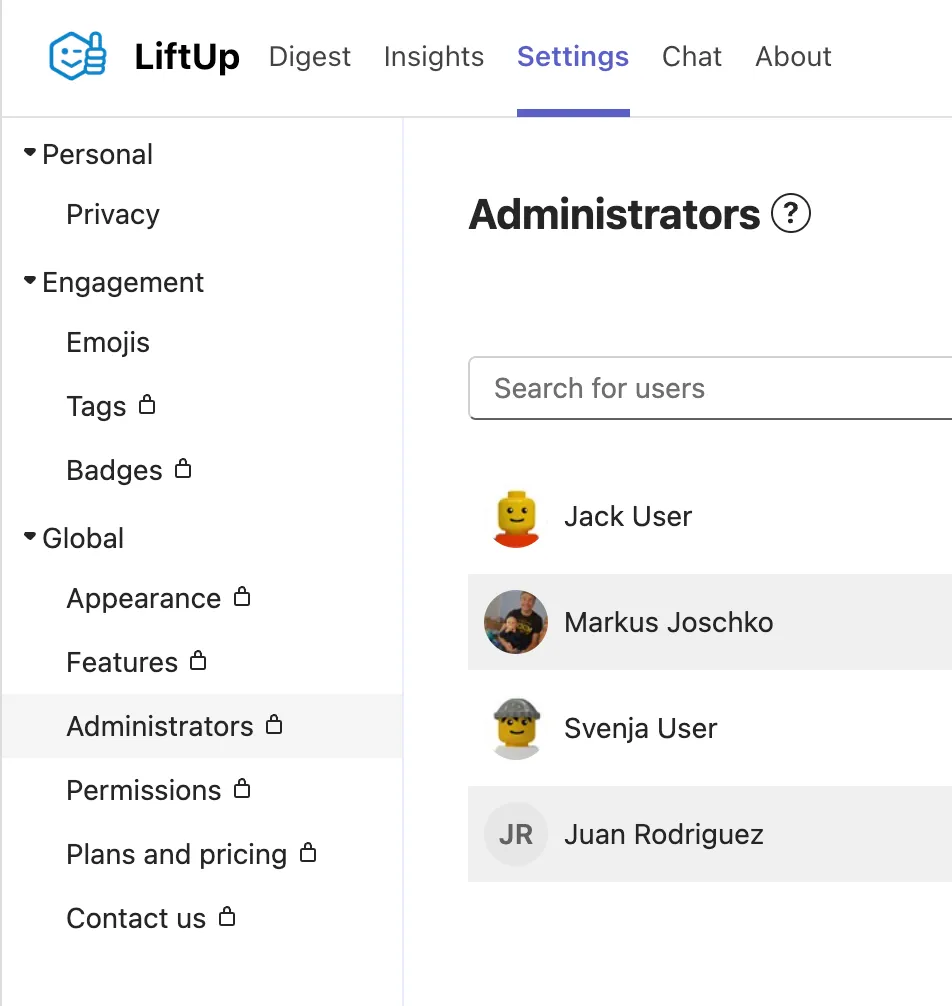
LiftUp is initially installed with minimal Microsoft Teams permissions, sufficient for evaluation and usage within small teams. For richer and better-performing operations, LiftUp needs additional permissions (e.g., showing user avatar images and faster praise Digest pages).
To grant these permissions, use the “Consent for all users” button on the “Settings -> Permissions” page.
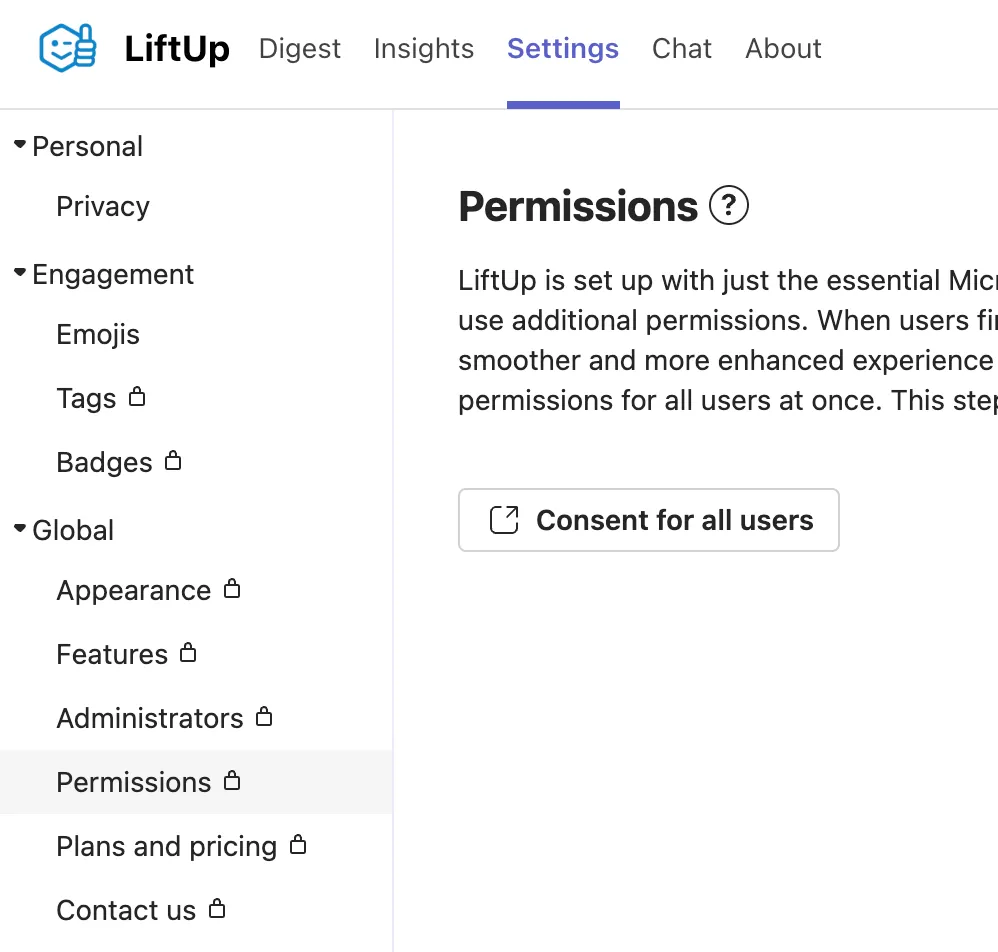
Alternatively, an administrator can visit the LiftUp configuration in your organization’s Teams Admin center, select “Go to Azure Directory,” and “Grant admin consent” there.
LiftUp benefits from being tailored to your organization. If you are an admin, check the configuration guide.